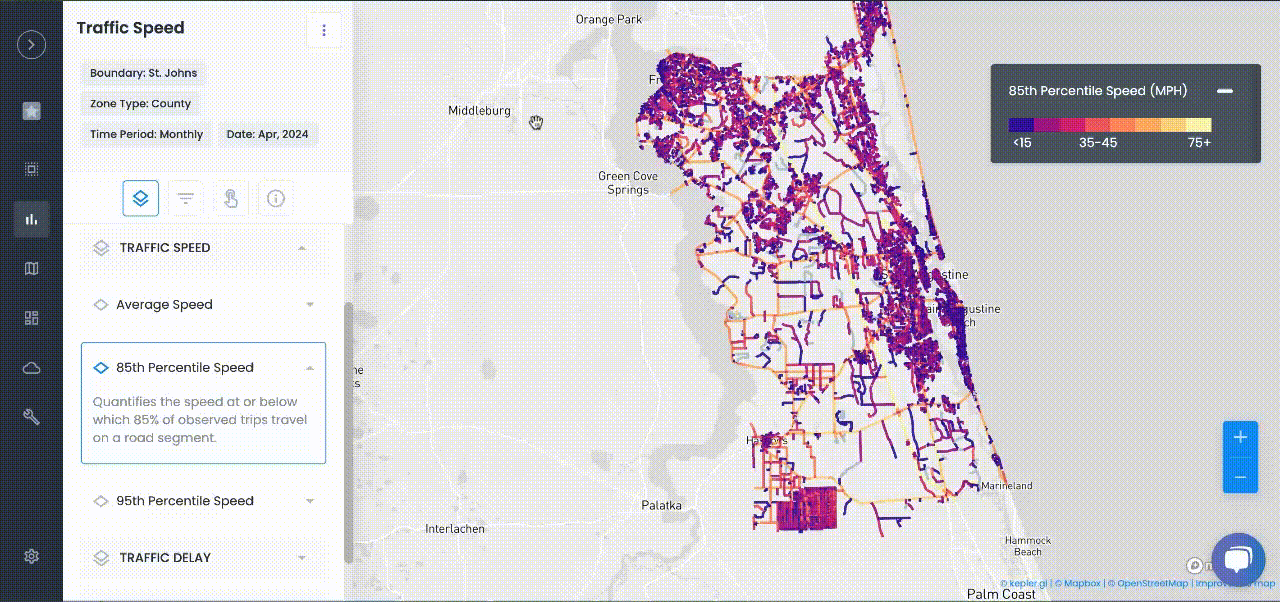
Road Safety
The Role of Lane Width and Separation in Road Safety Analytics
Accurate road characteristics—like lane counts, speed limits, and sidewalks—help cities improve traffic safety and emergency planning
Accurate road characteristics—like lane counts, speed limits, and sidewalks—help cities improve traffic safety and emergency planning.
Road design geometry plays a critical role in traffic safety. Two key attributes – lane width and lane separation(medians or barriers) – strongly influence driving behavior and crash outcomes. Modern road safety analytics increasingly incorporate these factors to identify high-risk locations and guide safer street designs. This article explores how lane width and separation affect safety, and how planners can leverage data on these attributes to improve road safety outcomes.
Why Lane Width Matters for Safety
Lane width has long been a focus of roadway design, traditionally with the belief that wider lanes (e.g. 12 feet) are safer. The idea was that extra width provides more buffer for driver error. However, recent studies challenge this assumption. A national analysis of over 1,100 urban streets found no increase in crashes for lanes 9–11 feet wide compared to each other, but a significant jump in crashes on streets with 12-foot lanes. In fact, streets with 12 ft lanes saw much higher crash frequencies than those with 10 ft lanes, contradicting the old safety belief. The reason is tied to speed – wider lanes encourage higher driving speeds, which in turn raise crash risk and severity. As one researcher noted, wider lanes don’t actually give drivers more room to recover; they “just make drivers drive faster.”
In urban environments, slightly narrower lanes (10–11 ft) can serve as a form of traffic calming. They signal drivers to be more cautious and can naturally curb excessive speeds. At lower speed limits (20–25 mph), lane width differences have minimal safety impact. But on higher-speed roads (~35 mph), the study above found wider lanes became significantly more dangerous, with more crashes as lane width increased. Essentially, beyond a certain width, any added space mainly contributes to speed, not safety. This has led some cities to reconsider lane width standards on urban streets – for example, using 10 ft lanes by default and requiring justification to exceed that, rather than automatically designing 12 ft lanes.
For road safety analytics, tracking lane width on each segment is important because it correlates with speeding tendencies and crash risk. A road safety model or Vision Zero plan might flag wide-lane, high-speed corridors as candidates for interventions (like lane narrowing, road diets, or added bike lanes). Conversely, roads with extremely narrow lanes might warrant analysis for side-swipe or off-road incidents. The key is that lane width is a measurable risk factor – and today, Urban SDK can quantify the lane width of every road segment via aerial imagery. Planners armed with this data can identify where geometric design might be contributing to unsafe conditions.
The Safety Impact of Lane Separation (Medians)
“Lane separation” generally refers to the use of medians, center barriers, or separation buffers to divide traffic moving in opposite directions (or to separate vehicle traffic from bike/pedestrian lanes). Separation is a proven safety countermeasure, especially for preventing head-on and cross-over collisions. Undivided two-way roads allow the possibility of devastating head-on crashes if a driver drifts over the centerline. Introducing a median – whether a painted center buffer, a raised median, or a barrier – can dramatically reduce this risk.
Data underscores the life-saving value of medians. On high-speed roads, installing median barriers has led to a 97% reduction in cross-median crashes on rural four-lane freeways. Even on urban arterials, adding a center median or turn lane can separate opposing flows and reduce head-on collision chances. The Federal Highway Administration identifies median installation as a “proven safety countermeasure,” noting that only ~8% of fatalities on divided highways are from head-on crashes (compared to a much larger share on undivided roads). In other words, separation saves lives by design – it’s far harder for a vehicle to end up in the path of oncoming traffic.
Beyond preventing head-ons, medians and separation features have other safety benefits captured in analytics. Medians provide refuge for pedestrians crossing wide roads, reducing the risk of multi-lane crossings. Physical separators (like concrete barriers or guardrails) not only protect against cross-over crashes but can also slow traffic by visually narrowing the roadway. Even modest measures like painted two-way left turn lanes or “centerline hardening” treatments can organize traffic and reduce certain crash types.
From an analytics perspective, it’s critical to know which road segments have a median or separation, and what type. For example, safety models (such as the Highway Safety Manual methods) use “divided vs. undivided” as a key variable when predicting crashes. A city’s high-injury network might especially highlight undivided multi-lane arterials as dangerous outliers – these roads have traffic moving fast in opposite directions with only a stripe between them. By contrast, data might show that corridors with a center median have lower serious crash rates, indicating successful design. Thus, cities should inventory median presence, type, and width as part of their road data. Modern tools can even quantify median width or the presence of a turn lane vs. barrier.
Using Lane Geometry Data in Road Safety Analytics
With lane width and separation data in hand, how do transportation officials put it to use? One approach is risk factor analysis: identify correlations between these attributes and crash history. For instance, analysts can overlay crash hotspots on a map of lane widths. If many severe crashes cluster on 12-foot lane arterials lacking medians, that insight supports redesigning those roads (narrowing lanes, adding a median or buffer). In safety predictive modeling, agencies can include lane width and median as variables to compute expected crash frequency. Crash modification factors for adding a median or reducing lane width can quantify the expected crash reduction, helping build the case for certain projects.
Another application is prioritizing interventions and resources. A transportation department might have hundreds of miles of roads to assess – by using GIS-based safety analytics, they can filter for, say, all multi-lane roads over 40 MPH that have no median and lanes ≥12 ft. Those segments would likely be top priorities for safety audits or improvements (such as installing a center turn lane or narrowing lanes to reduce speeds). Conversely, planners can track locations where lanes are very narrow or separated by only paint, which might need different treatments (like adding delineators or improving markings).
Urban SDK’s platform facilitates these insights by providing a rich Roadway Characteristics data layer. This includes lane count, lane width, and separation width for each road segment, derived from aerial imagery and AI. By combining this with crash data and traffic speeds, the software can help pinpoint “geometry-related” safety issues. For example, if a city sees recurring lane-departure crashes on a particular curve, data might reveal that segment has wide lanes and no median – a recipe for trouble. Armed with that knowledge, engineers could propose adding a centerline rumble strip or narrowing the lanes with striping to encourage slower speeds.
Building Safer Streets with Data-Driven Decisions
Lane width and separation are foundational elements in road safety analysis. They shape driver behavior in ways that directly impact crash risk. Wider lanes often lead to higher speeds—and more severe crashes—while roads without medians leave little margin for error, increasing the likelihood of head-on collisions. Understanding these relationships through data allows planners and engineers to make more informed, targeted safety decisions.
With Urban SDK, cities can automatically measure lane widths and detect medians across their entire road network—no manual surveys required. This data can be analyzed alongside crash records, traffic volumes, and roadway classifications to build a complete picture of roadway safety. Officials can quickly answer questions like, “Where are geometry factors contributing to crash risk?” and identify streets where interventions like lane narrowing or median installation could reduce crashes. For instance, an overly wide downtown street might be re-striped to include a protected bike lane, improving multimodal safety without requiring reconstruction.
By incorporating lane geometry data into safety analytics, cities shift from anecdotal decisions to evidence-based action. This makes it easier to justify roadway redesigns (e.g., “Data shows this street’s width is linked to higher crash rates”) and track the impact of those changes over time. Aligning road design with real safety data—especially critical factors like lane width and separation—helps transportation leaders move closer to Vision Zero goals.
Urban SDK enables this alignment by delivering detailed lane geometry data and a powerful analytics platform that transforms raw measurements into actionable safety insights. With the right data at their fingertips, cities can confidently implement the changes that lead to safer, more efficient streets for everyone.
FAQs
Q1: Why is lane width an important factor in road safety?
Ans: Lane width directly affects vehicle speeds and crash risk. Wider lanes, especially those 12 feet wide or more, are linked with higher driving speeds and significantly more crashes in urban settings. Research shows that narrowing travel lanes to 9 - 11 feet does not increase crash frequency, and on roads with speed limits around 30–35 mph, narrower lanes are associated with lower crash rates.
Q2: How does lane separation, like medians, influence road safety?
Ans: Lane separation - using medians, center barriers, or buffers - greatly reduces the likelihood of head-on or crossover crashes. Installing median barriers on high-speed roads can reduce cross-median crashes by up to 97%. Medians also offer pedestrian refuge and can visually narrow the roadway, further calming traffic.
Q3: What data should cities collect to understand lane geometry’s impact on safety?
Ans: Cities should inventory lane widths, types of separation (e.g., painted buffer, median, barrier), and segment these features across their road network. This GIS-based data enables agencies to pinpoint where overly wide lanes or lack of separation correlate with crash hotspots and prioritize interventions like lane narrowing or median installation.
Q4: What do recent studies reveal about lane width, speed, and crash outcomes?
Ans: Large-scale reviews confirm that wider lanes encourage speeding, which raises both the risk and severity of crashes. In speed zones of 30–35 mph, roads with 12-foot lanes experience more crashes than those with narrower lanes. In urban low-speed areas, lane width has less impact, but excessively wide lanes encourage unsafe speeds regardless of posted limits.
Q5: How can modern analytics tools like Urban SDK help cities address lane geometry-related safety risks?
Ans: Urban SDK uses AI and aerial imagery to automatically measure lane width and median type for every road segment. Planners can overlay this data with crash and speed records, visually identify high-risk locations, and justify data-driven redesigns (e.g., road diets, protected bike lanes) to reduce speeds and crash severity.
Q6: Should cities always reduce lane width to improve safety?Ans: Not always - context matters. While 10–11 foot lanes are generally safest for urban arterials, extremely narrow lanes may increase sideswipes or off-road incidents in some settings. The best practice is to use data to match lane width and separation to each road’s speed, usage, and surrounding environment.

TRAFFIC ENFORCEMENT FEATURES
80% of citizen complaints
are a perception problem
Urban SDK provides precise hourly speed data to evaluate complaints and deploy resources efficiently for the greatest impact to public safety.
Urban SDK provides precise hourly speed data to evaluate complaints and deploy resources efficiently for the greatest impact to public safety.
Target Speeding
Identify hot spots, validate monthly speeding trends and monitor vulnerable areas like school zones.
Improve Safety
Crash and citations location information to compare speed trends month over month
Fast Response
Respond to citizen complaints sooner with address search and exportable reporting
Deploy Assets
Generate maps for traffic enforcement by time of day, location or division to deploy officers to known problem areas.
RESOURCES
Customer Success
See how public sector leaders succeed with Urban SDK.
WEBINAR
Identify speeding and proactively enforce issues
See just how quick and easy it is to identify speeding, address complaints, and deploy officers.







